Medical Photography: Limitless Applications
The range of imaging modalities available for the enhancement of clinical trial endpoint data is as broad as the range of treatment methods available. Whether in the laboratory, clinical or real-world environment, medical photography can be tailored to document working practices and record both subjective and objective efficacy data.
The range of imaging modalities available for the enhancement of clinical trial endpoint data is as broad as the range of treatment methods available; microscopic detail can be enlarged, filtration can visualise the invisible, lighting can emphasise unique features – whether specific surface detail or precise color characteristics. In addition, such techniques can be combined with systems that capture either the briefest instant in time or time-lapse the slowest transition. Whether in the laboratory, clinical or real-world environment, medical photography can be tailored to document working practices and record both subjective and objective efficacy data.
Images should be considered as the recording of a subject, material or event(s) in time, whether directly or indirectly observed or measured. The generic term ‘medical photography’; can be taken to reference any data represented by a visual arrangement of pixels, whether originating from a smart phone, video camera, 3D scanner or dedicated medical imaging device. Those formalizing research concepts are encouraged to consider the possibilities available by collecting and combining data via the visual spectrum and beyond. The systems and practices outlined below introduce the diversity of techniques, while providing practical examples of both the seen and unseen effects.
Electromagnetic Radiation (EMR)
The subject matter to be captured may be fixed but controlling those wavelengths of EMR which illuminate it and then filtering the recording medium, offers the possibility of an infinite number of unique capture situations. This section, seeks to provide insight with brevity, by identifying those common imaging practices associated with the wavelengths visible to the human eye and those groups immediately either side.
Short wavelength radiation:
Ultraviolet (UV) photography records details or features not visible to the human eye. Dermatologically it is utilized to visualize subcutaneous skin damage e.g. subtle bruising, the effects of sun exposure or fungal infections.
X-ray imaging occupies a separate field of expertise with regards to capture systems, however the analysis techniques outlined below are equally applicable to any combination of clinical images.
Figure 1. Visible and UV photographs with computerized mask calculating cutaneous pigmentation areas on a child with light brown hair (L) and a child with red hair (R).1

Long wavelength radiation:
Near-infrared medical photography offers applications to see through the skin surface toward the vessel structure beneath and filtration can distinguish between reds which appear identical but contain different characteristics.
Far-infrared (thermal) thermal imaging devices, available in a range of sizes and sensitivities, are predominantly employed to identify fluctuations in inflammation and blood flow.
Figure 2. Oncology thermography sequence, (L-R) Baseline, Months 3, 6, 9 & 12.2

Visible radiation:
Countless combinations of both light source and reflected filtration provide the researcher with a wealth of opportunity and control to ensure that the desired information is recorded.
Light source filtration enables the medical photographer to illuminate subject matter with the selected quantities of desired wavelengths. The visual representation of any subject matter is directly linked to the illuminating light source. If two areas of interest appear identical under one light source but are clearly distinguishable when viewed under a light source of different composition, then the characteristics of the metameric pair can be distinguished. Applications include prosthetics and medical cosmetics, in addition to the quality control of medical devices, drug manufacturing and packaging.
Figure 3. Metamerism; two medicinal products/devices with different spectral characteristics are viewed as the same under daylight illumination (top), when viewed under a different light source (such as a tungsten bulb) the colours appear to mismatch (bottom).3
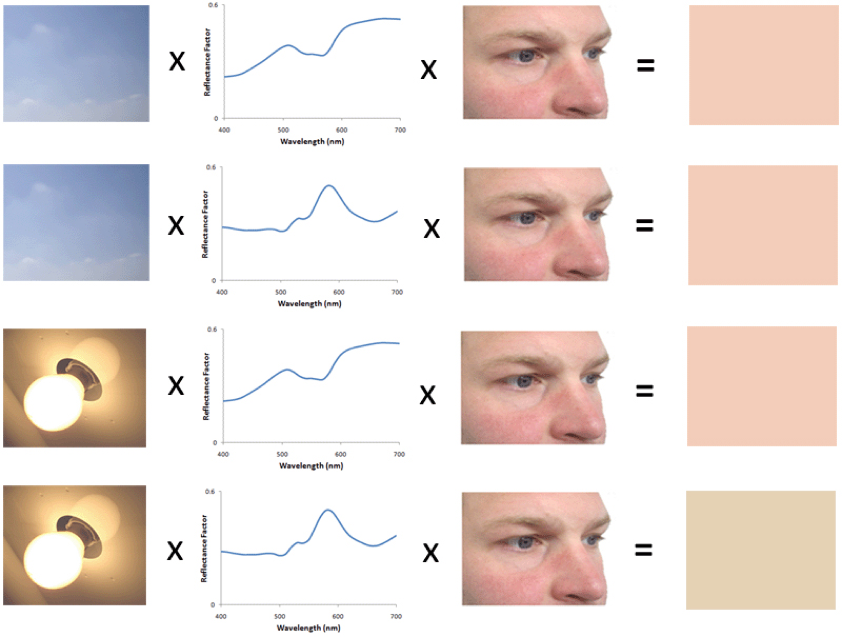
Reflected filtration ensures that only selective wavelengths reach the observer or imaging sensor. In combination with the spectral sensitivity of the recording medium, such filtration can be used to control the individual characteristics for a particular area of interest (AOI). Applications include recording specific wound management, hair, nail and dermatological details.
Figure 4. Monochromatic Fundus Photography; Green channel only from original RGB image (L), monochrome 490nm blue-green filter employed to identify anomaly (R).4

Combined filtration, controls both the light source and that reflected, applications include cross polarization; allowing specular reflection to be eliminated so identifying deeper layers of skin or samples through vials etc. Similarly, the diffraction characteristics of Birefringence materials such as plastics and crystals can be recorded. Applications as with Source and Reflected Filtrations above.
Figure 5. Calibrated thumbnail images; on-camera flash illuminant (L), crosspolarised filtration of flash and lens (R).5
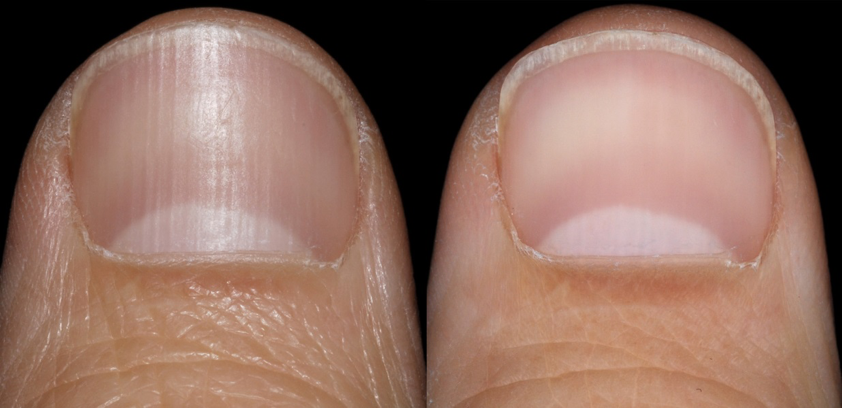
Fluorescence imaging, either by induced exposure to specific wavelengths of EMR and/or in combination with photosensitizers introduced to identify specific subject content. Applications vary widely from cellular to full body imaging, dentistry to oncology and from the laboratory to theatre.
Figure 6. Fluorescence molecular imaging to improve lesion identification and accurate demarcation of cancer margins; (L-R) visual, flourescent and combined images.6

Capture options
Professional photography equipment contains a wealth of variables for recording specific characteristics, an overview of the fundamentals being:
- Lighting, in addition to those techniques highlighted above; the direction, intensity, area and constituent parts of the chosen light source can all influence the appearance of the subject matter recorded. The recording medium will have specific sensitivities, characteristics, resolution and capture settings selected, before an AOI is rendering with optimum detail.
- Lens choice, the focal length of lenses is primarily dictated by the capture environment; it also directly alters image perspective, depth of field, definition and brightness level between image center and edge. In short, lens choice should be considered carefully, especially if objective analysis is required - generally the higher quality lens the less inconsistencies occur.
- Photomacrography is the close-up recording of a subject up to 1:1, between subject and capture medium. Beyond which the image can obviously be enlarged many times to depict detail hitherto unseen by the naked eye.
Figure 7. 1cm skin nevi (L-R); original captured via calibrated system, automated outline and threshold selections of pigmented areas for objective measurement.5
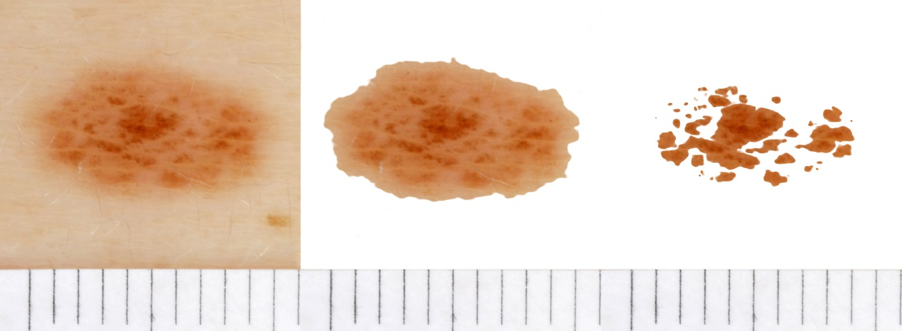
Photomicrography uses a microscope to record detail at greater than life size. From desktop microscopes, with all the illuminant variables available to electron microscopes with extreme magnifications, the resultant image is still an arrangement of pixel values for interpretation.
Schlieren photography records changes in the refractive index of a transparent medium; practical applications include recording the flow of gases or liquids as they mix or move around objects.
Figure 8. Schleiran images of subject coughing (L-R); without a mask, wearing a standard surgical mask and while wearing an N95 mask.7
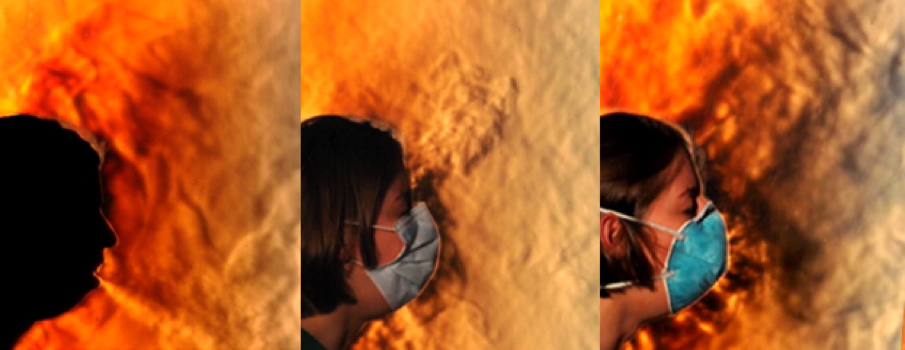
Dedicated imaging systems
Employing specific capture methods and filtration of the visual spectrum enables the competent medical photographer to construct a tailored imaging system. The construction process takes into account the practical variables and limitations, before being validated for each client’s specific needs. On occasion, there will already be an off-the-shelf imaging system which meets the client’s requirements. Such systems should always be validated in respect to their intended use, as they often have a rigid area of application. Dedicated imaging systems are under constant development and innovation; those areas most commonly used by medical photographers are:
Retinal imaging techniques use dedicated imaging devices to record retinal or choroidal detail. These techniques include sodium fluorescein angiography, indocyanine green angiography, red free photography, stereo photography and scanning laser ophthalmoscopy.
3D imaging systems vary in size and method of data acquisition from macro to full body; multiple images, projected patterns or laser scanners reconstruct the original. Devices range from high-street compact cameras such as the Fujifilm Finepix 3D, to dedicated ulcer measurement devices such as the AranzMedical Silhouette and 360° full body imaging systems such as that from 3dMD.
Figure 9. 2D view and 3D renditions; pre facial dermal filler (L), post procedure with 34.7% depression reduction (R).8

Skin characteristics; blood flow and sun damage can be captured and quantified against industry color standards or individual manufacturer standards. Systems, such as the Siascope from Cambridge Design, the Canfield Visia and X-rite’s Capsure, offer possible alternatives to adapted cameras for certain applications.
Image Metrics
Whether through subjective expert review or objective analysis algorithms, measurements taken from images should be made in the full knowledge of the variables introduced by the equipment, materials and processes involved. Piloting capture techniques ensures the system is sensitive and precise enough to produce the data required, with processes validated against standardized reference targets or set analysis parameters.
Photometry is concerned with the measurement of light and identifies how different wavelengths of the EMS interact with subject matter and ultimately how this is represented. The resultant tone and color characteristics can be measured in calibrated systems to produce objective response (color) data.
Photogrammetry is the measurement of X,Y, Z dimensions from images, such measures can be employed objectively, or in combination with photometry, or through subjective clinical interpretation of changes between images.
Figure 10. Antiscarring study, month 12 endpoint images; IMP (i), placebo (ii), and standard care (iii).9
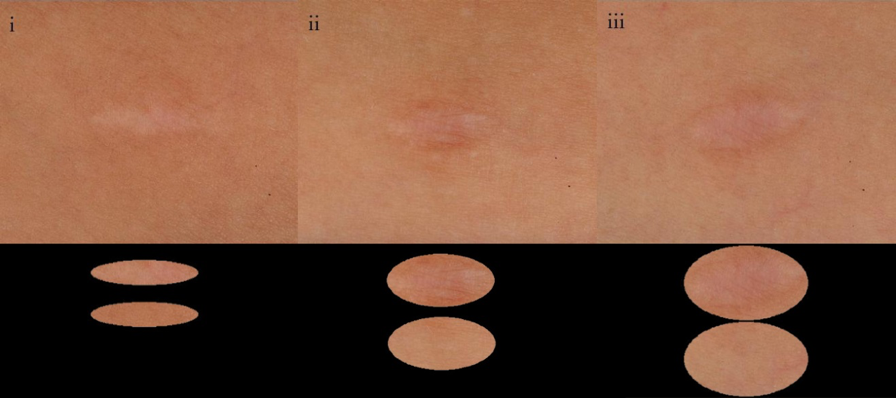
Objective measures
Scar color compared to adjacent skin colou (% change); i) scar 7.3% lighter, ii) scar 7.6% darker, iii) scar 5.8% darker.
STD in scar colors compared to STD of adjacent skin; i) scar 1, ii) scar 3.4, iii) scar 1.6.
Time; the measurement of time or those events that occur within a set period, can be visualized through numerous time-related capture techniques. To obtain quantifiable measurements from such images, it is essential that the exposure duration and/or the time elapsed between individual images is known.
High speed photography/video captures events which occur too fast to be observed by the naked eye, such as the failure of a device. Individual images or a timed sequence may be required for evidence, quantification or for subjective review.
Figure 11. Chronic venus leg ulcer sequence during split dressing treatment; baseline (top), months 1-3 treatment period beneath.5
Columns; original images with treatment areas identified (L), area selection masks (C), area and outline measurements per treatment (R).
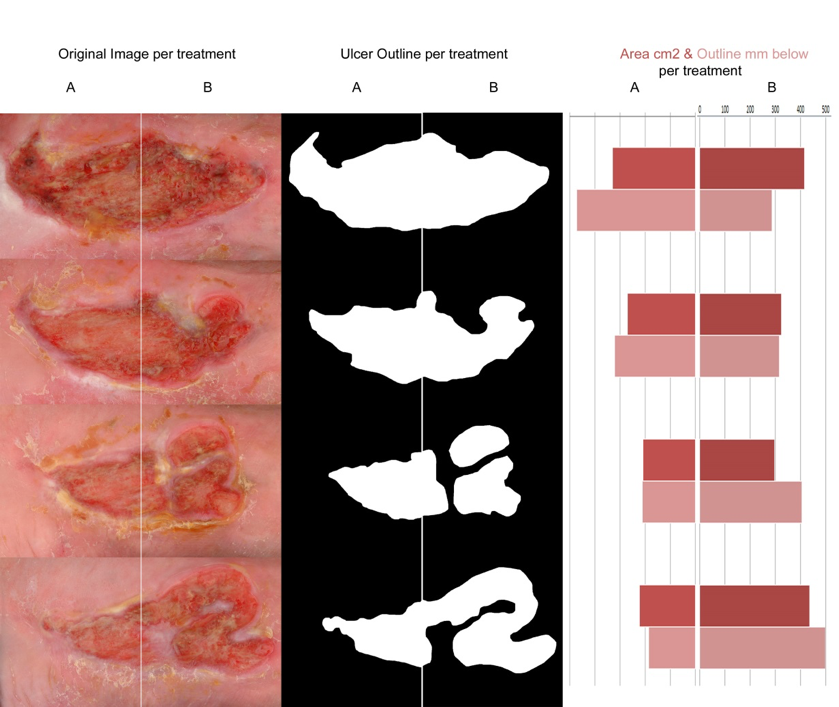
Time lapse photography/video enables extremely slow events to be hastened, allowing the sequence of events, or overall outcome to be interpreted further. Applications include monitoring the movement, growth, decay or interaction of skin or cultures.
Chronocyclography and Stroboscopic photography offer alternate methods to record movement over time. They identify both the path taken and the time associated; applications include tracking the motion of the body, limbs or devices.
These options introduce the variety of imaging techniques available to the clinical researcher, with the chosen systems ultimately being influenced by cost, controllability, availability and ease of use. Imaging applications are only limited by the subject matter and the willingness of the sponsor to explore beyond the realms of conventional (off the shelf) cameras and lighting.
Medical photography is a scientific discipline and clinical photographers work alongside healthcare and research scientists, if there is a possibility of imaging being required, there is a strong case for a photographer who knows and understands the imaging process to be consulted from the outset.
Kevin Jacob
Senior Medical Photographer
Illingworth Research Ltdwww.illingworthresearch.com
Kevin Jacob is Senior Medical Photographer at Illingworth Research Limited, offering medical photography for clinical trials as well as on site and home research nursing services and traditional CRO services. Kevin has 15 years of clinical research experience, having worked as Principal Medical Photographer within the CRO and biotechnology industries following a spell as a crime scene photographer in London. He is experienced in translating and managing the imaging requirements from synopsis to endpoint delivery.
He has extensive experience in the procedural and photographic aspects of pre-clinical and Phase I-III studies. Kevin has photographically managed over 40 imaging studies where image assessments formed the primary/secondary endpoint - whether subjective image review or objective analysis. He is experienced in 2D and 3D imaging including videography, from studies with a single site up to global 60 center studies. He has worked as imaging lead on studies with indications including; anti-scarring, accelerated healing, plastics, dermatitis, immune system, fungal conditions and vascular therapeutic areas.
To learn more about our medical photography services, please contact info@illingworthresearch.comReferences
- Ryan, G., et al. Sun damage in ultraviolet photographs correlates with phenotypic melanoma risk factors in 12-year-old children. Journal of the American Academy of Dermatology. Oct 2012; 67(4): 587–597.
- Keyserlingk, P., Ahlgren, P., Yu, E., Digital Infrared Thermal Imaging. Oncology News International. Sept 1997; 6(9).
- Carroll, C., Carroll, M., Colour Science for Silicone Prosthetics. Spectro Match. May 2014 http://www.spectromatch.com/Pages/Downloads/Colour%20Science%20for%20Silicone%20Prosthetics.pdf
- Bennett, J., Monochromatic Fundus Photography. Ophthalmic Photographer’s Society. June 2014 http://www.opsweb.org/?page=Monochromatic
- Illingworth Research image library (Jacob, K)
- Ntziachristos, V., Glatz, J., Shifting the paradigm in surgical vision with fluorescence molecular imaging. Nature Medicine 2011 17: 1315-9.
- Tang, J., et al. A schlieren optical study of the human cough with and without wearing masks for aerosol infection control. Journal of the Royal Society. 2009; 6: 727-736.
- Prendergast, D., Volume Measurements, Derma Fillers. Miravex Ltd. July 2014 http://www.miravex.com/english/antera_3d/volume_measurements-11.html
- Bush, J., et al. Therapies with Emerging Evidence of Efficacy: Avotermin for the Improvement of Scarring. Dermatology Research and Practice, 2010, ID 690613.
How Digital Technology and Remote Assessment Strategies Can Aid Clinical Trial Research
July 24th 2020While there's been hopeful news on treatments and vaccines, sponsors should plan to discuss necessary strategies and contingencies at the outset of new studies or re-opening of halted studies during the COVID-19 pandemic.